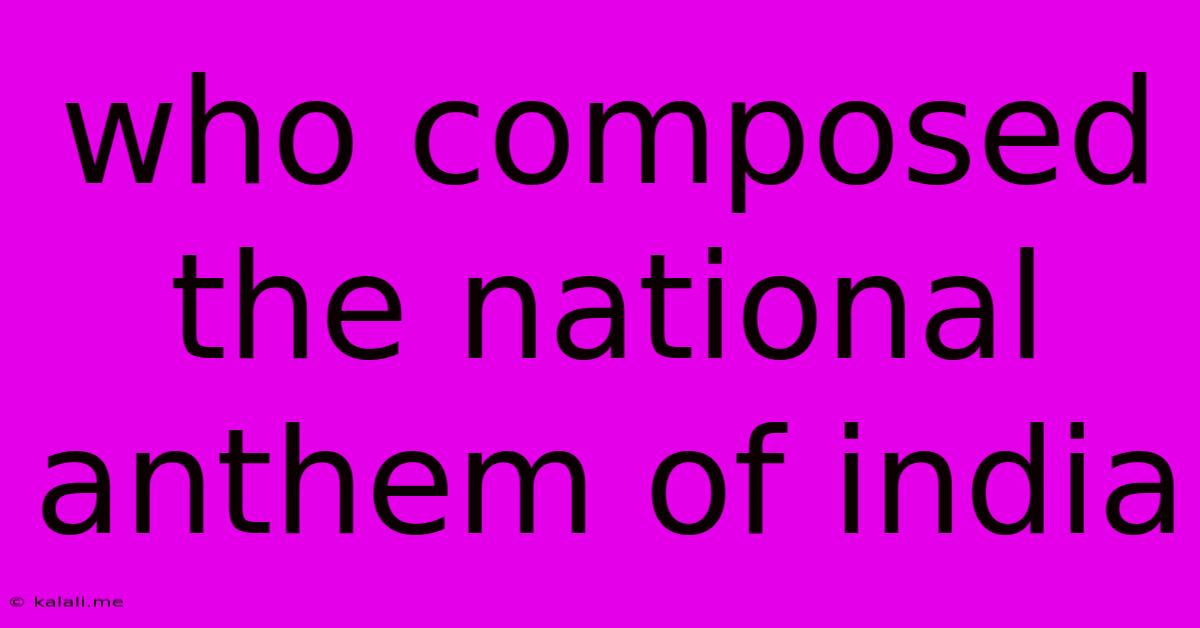Who Composed The National Anthem Of India
Kalali
Jun 11, 2025 · 3 min read

Table of Contents
Who Composed the Indian National Anthem?
India's national anthem, "Jana Gana Mana," is a powerful and evocative piece of music that stirs patriotic feelings in millions across the country. Knowing the composer behind this iconic anthem is crucial to understanding its history and significance. This article delves into the life and work of the man who gave India its soul-stirring national song: Rabindranath Tagore.
Rabindranath Tagore, a towering figure in Bengali literature, music, and art, wasn't just a composer; he was a visionary poet and philosopher whose works continue to resonate globally. Born in Calcutta (now Kolkata) in 1861, Tagore's influence extended far beyond the borders of India. He received the Nobel Prize in Literature in 1913, a testament to his profound contribution to world literature. But his creative genius wasn't limited to poetry; he was also a prolific composer, painter, and educator.
Tagore's Composition of Jana Gana Mana
Tagore composed "Jana Gana Mana" in 1911, originally as a Bengali patriotic song. It wasn't immediately adopted as the national anthem. The song, written in the Brahmo Samaj hymn style, was originally presented as a tribute to King George V during the 1911 Delhi Durbar. While initially presented as a tribute, its powerful and universal message of unity and devotion to the motherland transcends any specific ruler or regime.
The lyrics were originally written in Sanskrit-influenced Bengali, reflecting Tagore's deep understanding of Indian culture and history. The powerful imagery of the song evokes feelings of national pride and unity. The song's majestic melody perfectly complements the poetic beauty of its lyrics.
The Anthem's Adoption and Significance
While composed in 1911, "Jana Gana Mana" wasn't officially adopted as the Indian national anthem until January 24, 1950, after India gained independence. The Constituent Assembly of India formally adopted it as the national anthem, signifying its official recognition as a symbol of national identity and unity.
The anthem's popularity quickly spread throughout India, becoming a powerful symbol of national pride and a cornerstone of Indian identity. It's sung at numerous occasions – from official ceremonies to school functions and sporting events – uniting people from all walks of life.
Beyond the Anthem: Tagore's Legacy
Tagore's legacy extends far beyond the composition of "Jana Gana Mana." He left behind a vast body of work, including poems, novels, short stories, songs, and plays. His contributions to Bengali literature and Indian culture are immeasurable. He also founded Visva-Bharati University, a renowned institution dedicated to promoting cross-cultural understanding and education.
In conclusion, Rabindranath Tagore's composition of "Jana Gana Mana" is a significant event in Indian history. His creation transcends its role as a national anthem, serving as a testament to his artistic genius and his profound understanding of the Indian spirit. It's a song that continues to inspire and unite the people of India, solidifying its place as a timeless classic. Understanding the composer, therefore, enhances our understanding and appreciation of the anthem itself.
Latest Posts
Latest Posts
-
What Was The First Word Processing Program Used In 1979
Jun 12, 2025
-
The Ends Of A Long Bone Are Called The
Jun 12, 2025
-
Which Planet Has The Fastest Revolution
Jun 12, 2025
-
Least Common Multiple Of 4 6 And 10
Jun 12, 2025
-
Which Of The Following Pairs Are Incorrectly Matched
Jun 12, 2025
Related Post
Thank you for visiting our website which covers about Who Composed The National Anthem Of India . We hope the information provided has been useful to you. Feel free to contact us if you have any questions or need further assistance. See you next time and don't miss to bookmark.